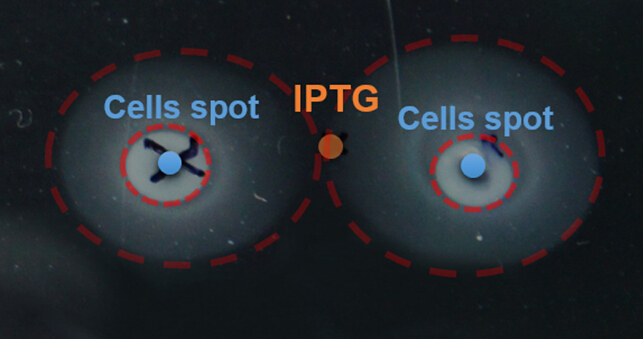Part:BBa_K1412001
Endow the E.coli engineered strain(CL-1) the ability of chemotaxis
What it is
The expression of LacI and CheZ is under the control of pBAD and pLac promoter. This part enables us to reprogram chemotaxis of engineering E.coli CL-1 (‘’CheZ’’ gene knocked out) thus we could regulate chemotaxis by IPTG and L-Arabinose.
What it does
When L-Arabinose is added, pBAD promoter is activated, expressing repressor LacI, inhibiting the expression of CheZ. When IPTG is added, IPTG combines with LacI, forming a more stable complex, thus relief the inhibition of pLac and CheZ would be expressed to make bacteria regain the chemotaxis ability.
How to use it
Using IPTG as inducer and L-arabinose as inhibitor to govern the chemotaxis of the engineering bacteria.
Experimental data
More information in linking page of the following pictures.
Characterization of backbone effect

By adding chloramphenicol of gradient concentrations. iGEM14_[http://2014.igem.org/Team:XMU-China# XMU-China] found that the best chemotaxis ability will be got as the concentration of chloramphenicol is 50μg/ml.
Characterization of IPTG effect

iGEM14_[http://2014.igem.org/Team:XMU-China# XMU-China] set the concentration of chloramphenicol at 50ug/ml. By adding gradient concentration of IPTG, they found that when the concentration of IPTG lies between 0.02 and 0.075, the chemotaxis distance is better than the others.

As the concentration of IPTG keeps on decreasing as it spreads out. We spotted IPTG with its concentration a little higher than the optimum. We observed that reprogrammed bacteria swim to IPTG source which seemed that the bacteria were attracted by IPTG.
Characterization of L-arabinose effect

iGEM14_[http://2014.igem.org/Team:XMU-China# XMU-China] set the concentration of chloramphenicol at 50μg/ml and the concentration of IPTG at 0.025mM. They found that the most efficiency inhibition L-Arabinose concentration is 0.2% and chemotaxis ability will be a little stronger at the concentration of 0.02%.
Using semisolid culture medium to draw geometry pattern
iGEM14_[http://2014.igem.org/Team:XMU-China# XMU-China] set the concentration of IPTG and L-Arabinose on the plate at 0.025mM and 0.02% respectively, then choose two points 0.5cm (up) [1cm (down)] away form each other on the plate. iGEM14_[http://2014.igem.org/Team:XMU-China# XMU-China] achieved their goal to command the CL-1 to form one branch of hyperbolic pattern by spotting 0.25mM IPTG mixed with “CL-1” (√) and 1% L-Arabinose (X) on the semisolid culture medium.

Distances of the points on the critical line to the IPTG spot (focus), and the L-arabinose line (directrix) are in a fixed ratio (eccentricity). If the ratio is equal to 1, the critical line is a parabola. If the ratio is larger than 1, it is a branch of a hyperbola. Then we conducted experiment to verify the mechanism.

Left boundary of the colony is regarded as the critical line. We found that cells has the tendency to swim away from L-arabinose line which is an expected performance of the circuit.
protocol
1.Transformation
2.Extract plasmids
3.Digestion
4.DNA gel electrophoresis
5.Gel Extraction
6.Ligation
7.Transformation
8.Extract plasmids
9.Digestion
10.DNA gel electrophoresis
11.Transform the plasmid into CL-1
Sequence and Features
- 10COMPATIBLE WITH RFC[10]
- 12INCOMPATIBLE WITH RFC[12]Illegal NheI site found at 125
- 21INCOMPATIBLE WITH RFC[21]Illegal BamHI site found at 65
- 23COMPATIBLE WITH RFC[23]
- 25COMPATIBLE WITH RFC[25]
- 1000COMPATIBLE WITH RFC[1000]
Reference
[1] [http://www.ncbi.nlm.nih.gov/pubmed/21998392/ Sequential Establishment of Stripe Patterns in an Expanding Cell Population Chenli Liu et al.Science 334, 238 (2011);DOI: 10.1126/science.1209042]
[2][http://www.biomedsearch.com/nih/Reprogramming-bacteria-to-seek-destroy/20453864.html Reprogramming bacteria to seek and destroy an herbicide Joy Sinha1, Samuel J Reyes1 & Justin P Gallivan1*]
More information, click here: [http://2014.igem.org/Team:XMU-China# XMU-China]
| None |


